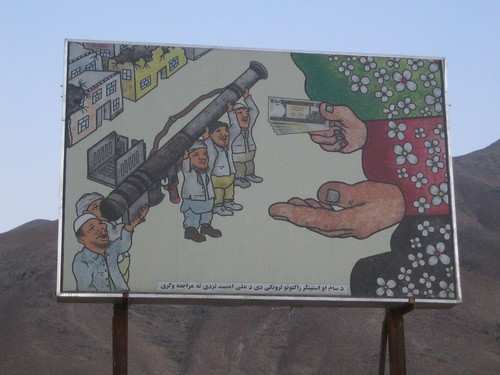Traditional Patterns: Genisis for War Rugs
Here is another example in the continuing series exploring how traditional Baluchi designs have morphed into war rugs.
Some earlier examples of traditional Baluchi patterns morphing into war rugs are: Murray Eilland’s Shindani rug with camel, a round vase of flowers pattern, Checkered Flowers pattern, also called Lateef Khel, Two Deer patern, Vase of Flowers, and a pattern from the Weavings of War exhibition.
National Geographic Society Map of the Day is War Rug
Today, to mark the February 5 ‘Soviet Exodus’ from Afghanistan, The National Geographic Society is using warrug.com’s Rug #426 as its Map of the Day today.
Smithsonian Magazine on War Rugs
Attorney Mark Gold has an oriental rug in his western Massachusetts home that most people call “nice-looking” until he tells them to inspect it more closely. Then they’re enthralled, because this is no run-of-the-mill textile—it’s what is called an Afghan war rug, and what it depicts is somber and stunning: cleverly mixed with age-old botanical and geometric designs are tanks, hand grenades and helicopters. “It’s a beautiful piece in its own right,” says Gold, “but I also think telling a cultural story in that traditional medium is fascinating.”
Natalie Marsh’s Curation of Miami U Museum Exhibition
Marsh’s combination of miniature painting and textiles from the museum’s collection provide excellent context to consider the war rugs.
Timuri Poppy Rug with Historical Precedent
High Tech: Predator Drone

Predator Drone from TBD1’s Flickr set
The Phantom Shield
Ben Osto introduced me to this interesting combination of tradition and contemporary as well as tribal and pop.
ArtNet Story
Low Tech: Mongolian Felt making
Weavings of War Exhibition Review
Hozain, who weaves on a loom in her home, is one of dozens of textile artists from around the globe whose work is included in a traveling national exhibit.
…
The common thread among these women of South Africa, Vietnam, Peru and the Middle East is the influence of warfare on their communities, said Lisa Gabbert, a humanities professor at Utah State University and project director. “This exhibit is important because it places women’s voices at the forefront of a public discussion on war,” Gabbert said. “Women’s voices, particularly the voices of poor women from developing countries, are usually left out of such discussions.”
Previous Posts about Weavings of War:New York opening, Hali review, , exhibition photos, and example of WoW rug and regular Baluchi pattern.











